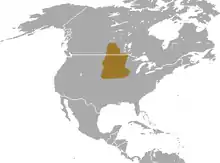| Prairie shrew[1] | |
|---|---|
| Scientific classification | |
| Domain: | Eukaryota |
| Kingdom: | Animalia |
| Phylum: | Chordata |
| Class: | Mammalia |
| Order: | Eulipotyphla |
| Family: | Soricidae |
| Genus: | Sorex |
| Species: | S. haydeni |
| Binomial name | |
| Sorex haydeni Baird, 1857 | |
 | |
| Prairie Shrew range | |
The prairie shrew (Sorex haydeni) is a small shrew found in the Canadian prairies and midwestern United States. At one time, this species was considered to be a subspecies of the similar cinereus shrew, S. cinereus.
It is brown in color with light grey underparts with a long tail. Its body is about 8 cm (3.1 in) in length including a 3 cm (1.2 in) long tail. It weighs about 4 g. This animal is found in open grasslands, often near water. It eats insects, worms, snails, small mammals and seeds. Predators include hawks, owls, snakes, and foxes. This animal is active day and night year-round. It mates between spring and fall. 3 to 6 young are born in a nest under a log or rocks.
References
- ↑ Hutterer, R. (2005). Wilson, D.E.; Reeder, D.M. (eds.). Mammal Species of the World: A Taxonomic and Geographic Reference (3rd ed.). Johns Hopkins University Press. pp. 288–289. ISBN 978-0-8018-8221-0. OCLC 62265494.
- ↑ Duncan, J.R.; Reichel, J.D. & Hammerson, G. (2008). "Sorex haydeni". IUCN Red List of Threatened Species. 2008. Retrieved 8 February 2010.old-form url
| Taxon identifiers |
|---|
This article is issued from Wikipedia. The text is licensed under Creative Commons - Attribution - Sharealike. Additional terms may apply for the media files.
